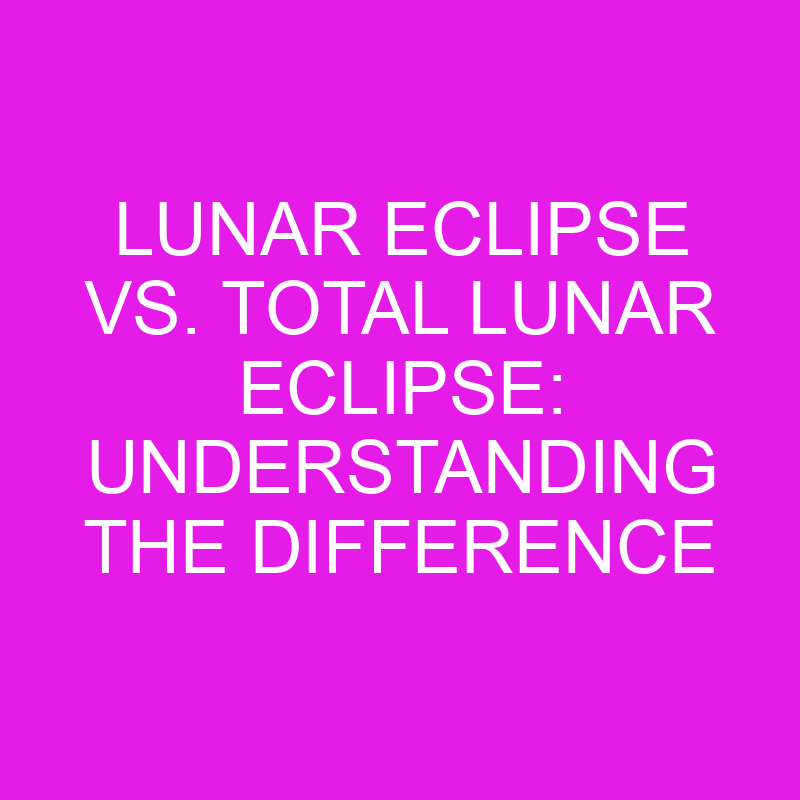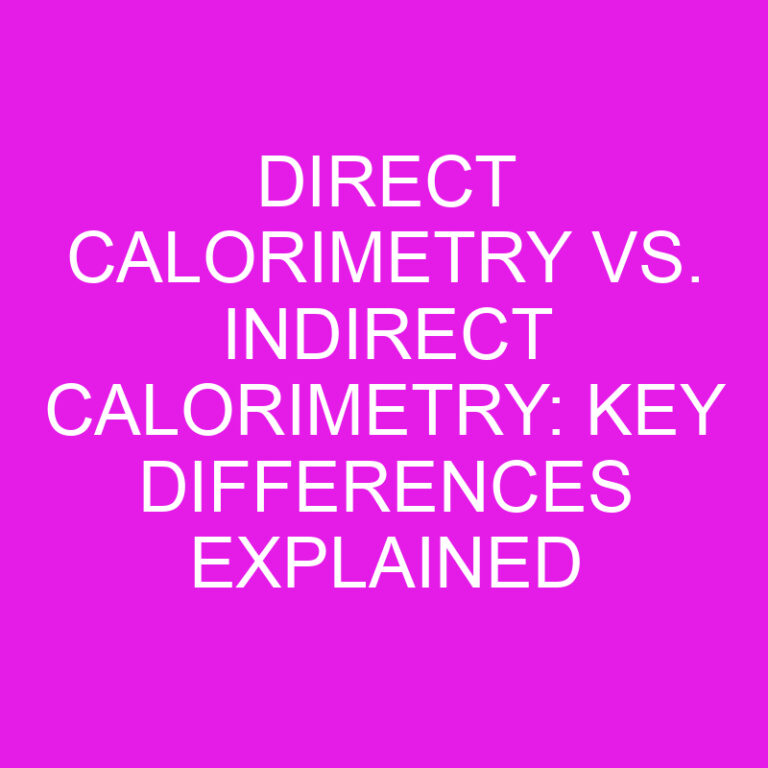
Lunar eclipses are celestial events that never fail to captivate our imagination. As the Earth aligns perfectly between the Sun and the Moon, a mesmerizing dance of shadows begins. But did you know that not all lunar eclipses are the same? In this article, I’ll unravel the intriguing difference between a lunar eclipse and a total lunar eclipse.
When we talk about a lunar eclipse, we’re referring to a phenomenon where the Earth casts its shadow on the Moon, causing it to darken. However, a total lunar eclipse takes this enchantment to a whole new level. During a total lunar eclipse, the Moon passes through the darkest part of Earth’s shadow, known as the umbra. This results in a breathtaking transformation, as the Moon takes on a deep reddish hue, earning it the nickname “Blood Moon.” So, let’s dive deeper into the nuances of these celestial spectacles and uncover what sets them apart.
Post Contents
Lunar Eclipse: Definition and Characteristics
A lunar eclipse is a fascinating celestial event that occurs when the Earth passes between the Sun and the Moon, casting its shadow on the lunar surface. This alignment creates a mesmerizing phenomenon where the Moon temporarily darkens, transforming the night sky into a captivating display of cosmic beauty.
During a lunar eclipse, three key celestial bodies are perfectly aligned: the Sun, the Earth, and the Moon. As the Moon orbits around the Earth, it occasionally enters into the Earth’s shadow, resulting in a lunar eclipse. This alignment can only occur during a full moon when the Sun, Earth, and Moon align in a straight line.
There are three types of lunar eclipses: penumbral, partial, and the most remarkable of all, the total lunar eclipse. Each type varies in terms of how deeply the Moon is immersed in the Earth’s shadow and the extent to which it darkens.
In a penumbral lunar eclipse, the Moon only passes through the Earth’s outer shadow, known as the penumbra. This type of eclipse results in a subtle darkening of the Moon, often not easily noticeable to the naked eye.
During a partial lunar eclipse, a portion of the Moon enters into the Earth’s umbra, the darkest part of the shadow. This causes a more noticeable darkening of the lunar surface, creating a breathtaking sight for sky gazers.
However, the most remarkable and awe-inspiring type of lunar eclipse is the total lunar eclipse. During a total lunar eclipse, the Moon passes entirely through the Earth’s umbra, resulting in a complete darkening of the Moon. But what makes it truly remarkable is the stunning transformation the Moon undergoes, taking on a deep reddish hue. This captivating phenomenon has earned the total lunar eclipse the poetic nickname of the “Blood Moon.”
It’s crucial to note that a total lunar eclipse doesn’t occur with every lunar eclipse. The alignment of the Sun, Earth, and Moon must be precisely in line for a total lunar eclipse to happen. This rarity adds to the allure and excitement surrounding this celestial event.
The mesmerizing beauty and rarity of a lunar eclipse make it a momentous occasion for both astronomers and stargazers alike. Whether it’s the subtle darkening of a penumbral eclipse, the partial obscuration, or the breathtaking transformation of a total lunar eclipse, these celestial events never cease to inspire wonder and awe.
Total Lunar Eclipse: Definition and Characteristics
A total lunar eclipse is the most remarkable and captivating type of lunar eclipse. It occurs when the Moon passes entirely through the Earth’s umbra, resulting in a complete darkening of the Moon. This remarkable phenomenon transforms the Moon into a deep reddish hue, earning it the nickname “Blood Moon.”
During a total lunar eclipse, the alignment of the Sun, Earth, and Moon is crucial. When the Earth passes between the Sun and the Moon, the Earth casts its shadow on the lunar surface. As the Moon enters the Earth’s shadow, it gradually darkens and takes on an eerie, reddish glow.
The duration of a total lunar eclipse can vary, but it typically lasts for a few hours. As the Moon moves deeper into the Earth’s shadow, it reaches totality, the point at which it is completely enveloped in the Earth’s umbra. This is when the Moon is at its darkest and exhibits its stunning reddish color.
One of the most fascinating aspects of a total lunar eclipse is the range of colors the Moon can display. The exact hue the Moon takes on during a total lunar eclipse depends on various factors, including the Earth’s atmosphere. Dust, pollution, and other particles in the Earth’s atmosphere can affect the color of the Moon, resulting in variations in the shade of red observed during each eclipse.
A total lunar eclipse is a rare occurrence, and the next one can sometimes be several years away. Astronomers eagerly anticipate these events and stargazers marvel at the mesmerizing beauty of a fully darkened Moon bathed in a deep red light. The rarity and breathtaking beauty of a total lunar eclipse have captivated civilizations throughout history and continue to inspire wonder and awe today.
A total lunar eclipse is an extraordinary celestial event that showcases the remarkable alignment of the Sun, Earth, and Moon. It is a captivating display of cosmic beauty that never fails to inspire awe and wonder among astronomers and stargazers.
The Earth’s Shadow: Umbra and Penumbra
During a lunar eclipse, the Moon moves through two different parts of the Earth’s shadow – the umbra and the penumbra. These are the key components that distinguish a regular lunar eclipse from a total lunar eclipse. Let’s explore these two shadowy regions and understand their role in creating this celestial phenomenon.
- Umbra: The umbra is the darkest and the central portion of the Earth’s shadow. When the Moon passes entirely through this region, a total lunar eclipse occurs. The umbra is responsible for the complete darkening of the Moon, giving it that characteristic reddish hue. This transformation is what makes a total lunar eclipse so captivating and earned it the nickname “Blood Moon.” The alignment of the Sun, Earth, and Moon must be precise for the Moon to pass through the umbra.
- Penumbra: The penumbra is the outer region of the Earth’s shadow, surrounding the umbra. When the Moon partially moves through this region, a partial lunar eclipse is observed. During a partial lunar eclipse, only a portion of the Moon appears darkened, as it doesn’t pass through the umbra completely. The penumbra is lighter in comparison to the umbra, resulting in a subtle darkening of the Moon.
It’s the interplay between these two shadowy regions, the umbra and the penumbra, that gives rise to the different types of lunar eclipses. While a total lunar eclipse provides the most dramatic transformation of the Moon, a partial lunar eclipse offers a glimpse of the Moon partially immersed in darkness.
Understanding the Earth’s shadow and the distinct regions it encompasses adds to the intrigue and fascination of lunar eclipses. Now that we have uncovered the nature of the Earth’s shadow, let’s delve further into the differences between a lunar eclipse and a total lunar eclipse.
Appearance and Visual Effects of a Lunar Eclipse
During a lunar eclipse, the Moon undergoes a remarkable transformation that captivates observers around the world. The alignment of the Sun, Earth, and Moon plays a crucial role in determining the visual effects and appearance of a lunar eclipse. Let’s dive into the fascinating details!
When the Moon enters the Earth’s shadow, it gradually begins to darken. In the case of a total lunar eclipse, the Moon passes entirely through the Earth’s umbral shadow, resulting in a complete darkening of the lunar surface. This stunning transformation gives the Moon its nickname, the “Blood Moon,” as it takes on a deep reddish hue.
The exact hue of the Moon during a total lunar eclipse can vary from a bright, coppery red to a darker, almost brownish shade. This variation in color is influenced by several factors. One significant factor is the Earth’s atmosphere. As sunlight passes through the Earth’s atmosphere, it undergoes scattering, with shorter wavelengths (such as blue and green) being scattered more than longer wavelengths (such as red and orange). This effect, known as Rayleigh scattering, causes the reddish tones to dominate during a lunar eclipse.
The appearance of the Moon during a lunar eclipse can also be affected by the amount of dust and pollutants in the Earth’s atmosphere. Volcanic activity or large-scale fires can release particles into the atmosphere, which can lead to a darker and more dramatic lunar eclipse.
Observing a lunar eclipse is a truly mesmerizing experience. As the Moon transitions from its usual bright white appearance to a captivating shade of red, it creates a mystical atmosphere. Many ancient civilizations believed that lunar eclipses held great spiritual and symbolic significance, and they continue to inspire wonder and awe today.
Whether you witness a total lunar eclipse or a partial lunar eclipse, the visual effects and awe-inspiring transformation of the Moon are sure to leave a lasting impression. Stay tuned as we explore more intriguing aspects of lunar eclipses in the following sections.
Appearance and Visual Effects of a Total Lunar Eclipse
During a total lunar eclipse, the Moon undergoes a remarkable transformation, gradually darkening as it enters the Earth’s shadow. As it passes through the Earth’s umbral shadow, the lunar surface is completely darkened, giving it a deep reddish hue. This captivating phenomenon has earned the total lunar eclipse the nickname “Blood Moon.”
The exact hue of the Moon during a lunar eclipse can vary, influenced by factors such as the Earth’s atmosphere and the amount of dust and pollutants in the air. These factors can cause slight variations in the color, ranging from a dark coppery red to a vibrant scarlet. The sight of the Moon bathed in this striking crimson glow is truly awe-inspiring.
As the lunar eclipse progresses, the Moon may appear to shimmer or glimmer due to the bending of sunlight around the Earth’s atmosphere, a phenomenon known as atmospheric refraction. This refraction is caused by the varying densities of the Earth’s atmosphere, which bend and scatter different wavelengths of light, resulting in a distorted and hazy appearance. This atmospheric refraction can give the Moon a slightly blurred or dream-like quality, further adding to the mystique of the eclipse.
Another stunning visual effect that can occur during a lunar eclipse is the presence of a reddish halo or “corona” around the Moon. This halo is caused by the scattering of sunlight by tiny particles in the Earth’s atmosphere. The particles scatter shorter, bluish wavelengths of light more strongly, while allowing longer, reddish wavelengths to pass through and create the halo effect. The combination of the reddish halo, the darkened lunar surface, and the shimmering atmospheric refraction creates a breathtaking scene in the night sky.
Observing a total lunar eclipse is a mesmerizing experience, and it has held great spiritual and symbolic significance throughout history. The visual effects and transformation of the Moon during a lunar eclipse are sure to leave a lasting impression. So, make sure to mark your calendar and take the opportunity to witness this celestial event whenever it occurs.
Conclusion
Experiencing a total lunar eclipse is a truly mesmerizing event that captivates both astronomers and casual stargazers alike. As the Moon enters the Earth’s shadow, it undergoes a stunning transformation, gradually darkening and taking on a deep reddish hue. This phenomenon, known as the “Blood Moon,” is a sight to behold.
The exact color of the Moon during a lunar eclipse can vary, influenced by atmospheric conditions and the presence of dust and pollutants in the air. This variation adds to the uniqueness and beauty of each eclipse, ranging from a dark coppery red to a vibrant scarlet.
Throughout history, the visual effects of a lunar eclipse have held great spiritual and symbolic significance. The shimmering and glimmering of the Moon, along with the appearance of a reddish halo or “corona,” create a breathtaking scene in the night sky.
Whether you’re a seasoned astronomer or simply someone who appreciates the wonders of the universe, observing a total lunar eclipse is an awe-inspiring experience that reminds us of the beauty and grandeur of our celestial surroundings. So, mark your calendars and prepare to be enchanted by the next lunar eclipse.
Frequently Asked Questions
Q: What happens during a total lunar eclipse?
A: During a total lunar eclipse, the Moon gradually darkens as it enters the Earth’s shadow. As it passes through the Earth’s umbral shadow, the lunar surface is completely darkened, giving it a deep reddish hue known as the “Blood Moon.”
Q: What causes the variation in color during a lunar eclipse?
A: Factors such as the Earth’s atmosphere and the amount of dust and pollutants in the air can influence the color of the Moon during a lunar eclipse. This can result in slight variations in color, ranging from a dark coppery red to a vibrant scarlet.
Q: Are there any visual effects during a lunar eclipse?
A: Yes, during a lunar eclipse, the Moon may appear to shimmer or glimmer due to atmospheric refraction. Additionally, a reddish halo or “corona” may be visible around the Moon, adding to the breathtaking scene in the night sky.
Q: What is the significance of observing a total lunar eclipse?
A: Observing a total lunar eclipse is a mesmerizing experience that has held great spiritual and symbolic significance throughout history. The appearance and visual effects of a lunar eclipse create a unique and awe-inspiring scene in the night sky.






